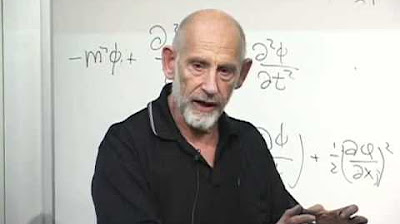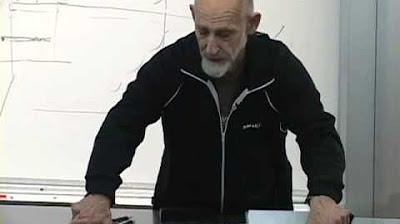Lecture 1 | String Theory and M-Theory
TLDRThe video script delves into the fascinating origins and principles of string theory, a theoretical framework in which the point-like particles of particle physics are replaced by one-dimensional objects called strings. It discusses how string theory emerged from the study of hadrons and their unusual behavior under high-energy scattering, leading to the concept that these particles are composite and not simple point particles. The script explores the mathematics of strings, their vibrational modes, and how they can be described in different frames of reference, including the light cone frame. It also touches on the connection between string theory and quantum gravity, and the implications for understanding the fundamental nature of particles and forces. The lecturer uses analogies such as springs and superconductors to illustrate complex concepts, providing a comprehensive and engaging overview of string theory's rich and intricate landscape.
Takeaways
- 📚 The origins of string theory were in hadron physics, not quantum gravity, and were initially related to particles like protons, neutrons, and mesons.
- 🧵 The concept of strings in string theory emerged from trying to understand the interactions between quarks, which were thought to be connected by one-dimensional 'strings' of force.
- 📈 The discovery of a linear relationship between the square of the mass and the angular momentum of hadrons led to the idea that hadrons were composite objects, not point particles.
- 🤔 The idea of gluons, which are now a fundamental part of quantum chromodynamics, was not initially part of the standard discussion in hadron physics.
- 🌌 The trajectories of hadrons, known as Regge trajectories, were found to be parallel, suggesting a universal relationship between the angular momentum and the square of the mass for all hadrons.
- ⚖️ The energy of a string is proportional to its length, which is a key concept in string theory and has similarities to the behavior of magnetic flux lines in superconductors.
- ⏳ In the infinite momentum frame, also known as the light cone frame, the motion of a relativistic system behaves non-relativistically with respect to motion in the plane perpendicular to the boost.
- 🎼 The mathematics of a non-relativistic string can be used to describe the physics of a relativistic string under certain conditions, which is central to the development of string theory.
- ⚛️ The string tension, a constant representing the energy per unit length of a string, is a property that theoretical strings and actual strings like those in superconductors share.
- 🔬 The energy spectrum of a string is quantized, similar to the energy levels of a quantum mechanical oscillator, which is an important aspect when considering the string's internal energy.
- 🤓 The study of string theory has led to insights into the nature of particles and fundamental forces, suggesting that what we perceive as point particles may actually have a more complex, string-like structure.
Q & A
What were the origins of string theory?
-The origins of string theory were in hadron physics, not quantum gravity. It was initially related to particles like protons, neutrons, and mesons, particularly when it was not yet confirmed that these particles had a quark content.
What was the significance of the straight line pattern observed in hadron physics?
-The straight line pattern observed in hadron physics, specifically in the plot of angular momentum (L) versus mass squared (M²), indicated that hadrons were composite particles, suggesting an internal structure rather than being simple point particles.
What is the Regge trajectory?
-Regge trajectories are relationships that describe the masses and spins of a series of hadrons. They are straight lines on a plot of angular momentum squared versus the square of the mass, indicating a quantized spectrum of particles.
How did the discovery of the gluon field contribute to the understanding of hadrons?
-The gluon field, which was initially not part of the standard discussion of hadrons, was later understood to be responsible for the strong force that holds quarks together within hadrons. The behavior of gluons contributes to the string-like properties observed in hadrons.
What is the role of the gluon field in the formation of strings between quarks?
-The gluon field is thought to act like a string connecting quarks. As quarks are pulled apart, the energy stored in the gluon field increases, leading to the creation of more gluons and an effective stretching of the 'string' without breaking it.
How does the concept of a string in string theory differ from a particle in quantum field theory?
-In string theory, a string is an extended object that can vibrate at different frequencies, each corresponding to a different particle type. Unlike point particles in quantum field theory, strings can stretch and have internal dynamics, which gives rise to a rich spectrum of particle-like excitations.
What is the connection between the energy of a string and its mass squared?
-The energy of a string, particularly its internal energy or the energy stored in its vibrational modes, is related to the mass squared of the particle it represents. This relationship is derived from the relativistic energy-momentum relation and is a key aspect of string theory.
How does the infinite momentum frame (light cone frame) simplify the description of relativistic strings?
-In the infinite momentum frame, the motion of a relativistic system is effectively non-relativistic in two dimensions. This allows physicists to use the mathematics of a non-relativistic string to describe the system, simplifying the analysis of particle dynamics and string interactions.
What is the significance of the quantization of energy levels in a string?
-The quantization of energy levels in a string implies that the string can only exist in discrete energy states. This leads to quantized mass squares for the particles represented by the strings, which is a key feature of the particle spectrum in string theory.
How does the concept of string tension relate to the energy stored in a string?
-String tension refers to the uniform energy per unit length that is stored in a string when it is stretched. This concept is analogous to the energy density in a magnetic flux tube or an electric field configuration, where the energy is proportional to the length of the tube or string.
What is the holographic principle, and how does it relate to string theory?
-The holographic principle is a concept in theoretical physics suggesting that all the information contained in a volume of space can be represented on the boundary to the same space. In the context of string theory, it implies that a higher-dimensional space can be described by a lower-dimensional boundary, which has implications for how strings are described in different frames of reference.
Outlines
📚 Origins of String Theory and Particle Physics
The first paragraph delves into the origins of string theory, which began in hadron physics rather than quantum gravity. It discusses the early understanding of particles like protons, neutrons, and mesons, before the discovery of quarks and gluons. The speaker also talks about the large number of particle states and the development of diagrams to represent these particles' properties, which led to the discovery of a pattern in the particle spectrum that resembled straight lines on a plot of angular momentum versus mass squared.
🧵 The Regge Trajectories and Hadrons
This section explores Regge trajectories, which are linear relationships between the angular momentum and mass squared of hadrons. The speaker explains that these trajectories were observed for various hadrons, like mesons, and were parallel to each other, suggesting a universal slope. The paragraph also touches on the quantization observed in the particle spectrum and the implications that hadrons are composite objects, not simple point particles.
🤔 Pion Scattering and Meson Exchange
The third paragraph discusses pion scattering and the peculiar observations made when calculating the contributions of various meson exchanges. The speaker talks about the redundancy in calculations and how this led to the idea that there might be an underlying structure, like strings, connecting quarks. The paragraph also introduces the concept of quark confinement and the idea that gluons might be the medium holding quarks together within hadrons.
🎼 Vibrations of Strings and Quantum Mechanics
The speaker introduces the idea that strings, which are theorized to make up hadrons, can vibrate and spin, unlike point particles like electrons. Using simple assumptions about the properties of these strings, the speaker discusses how one can calculate the energy as a function of angular momentum. The paragraph also explores the concept that strings might not break like ordinary objects when spun, hinting at a more fundamental nature of these strings.
🧲 Gluons and the Nature of the Strong Force
This paragraph explores the relationship between gluons and strings, suggesting that strings might be composed of gluons. The speaker explains that gluons, like the magnetic fields between poles of a magnet, cannot exist in isolation and always come in pairs. The paragraph also discusses how the gluon field might be visualized and how the energy stored in this field increases as the quarks within a hadron are pulled apart, potentially creating more gluons.
🌐 String Theory and Quantum Gravity
The speaker discusses the realization that string theory might not accurately describe hadrons but could be a theory of quantum gravity. The paragraph talks about the unexpected appearance of gravitons in string theory and how this initially seen as a nuisance led to a shift in perspective. The speaker also touches on the mathematics of strings and the concept of a world sheet, which is a two-dimensional surface that a string traces out in space-time.
🤓 Non-Relativistic vs. Relativistic Kinematics
The sixth paragraph contrasts non-relativistic and relativistic kinematics, highlighting the complexities of describing a relativistic string. The speaker discusses the energy of a particle in both frameworks and how the non-relativistic limit is appropriate for slowly moving particles. The paragraph also introduces the concept of the infinite momentum frame, which allows for a non-relativistic description of relativistic systems.
📐 The Mathematics of Interacting Strings
This section focuses on the mathematical description of a two-dimensional string, like a rubber band, moving in two dimensions. The speaker outlines the energy of the string in terms of kinetic and potential energy, with the potential energy described by Hooke's law for springs. The paragraph also discusses the transition to a continuum limit, where the string is modeled as an integral rather than a sum over discrete points.
🎉 Internal Energy and the Mass of Particles
The speaker connects the internal energy of a string to the mass of particles, suggesting that the internal energy of a string at rest corresponds to the square of the mass of the particle. The paragraph explores the idea that the energy stored in the string's vibrations and stretching is analogous to the internal energy within particles, which contributes to their mass.
⚖️ Mass Squared and the Energy of a Particle
The eighth paragraph discusses the relationship between mass squared and the energy of a particle within the framework of string theory. The speaker explains that the energy of a string, when it is stretched, corresponds to its mass squared. The paragraph also explores the quantization of string energy levels and how they relate to the mass squared of particles.
🧵 Strings, Flux Tubes, and Superconductors
The speaker compares strings in physics to flux tubes in superconductors, which both have an energy proportional to their length. The paragraph discusses how the energy density in a tube of magnetic flux is uniform, leading to an energy that grows linearly with the length of the tube. The speaker also connects this to the properties of hadrons, which exhibit string-like behavior.
🌌 The Holographic Principle and String Degrees of Freedom
The final paragraph touches on the holographic principle and how string theory describes strings using only two-dimensional motion, despite existing in a higher-dimensional space. The speaker also discusses the confinement of magnetic charge in quantum chromodynamics and how this relates to the behavior of strings in superconductors.
Mindmap
Keywords
💡String Theory
💡Quantum Chromodynamics (QCD)
💡Hadrons
💡Quarks
💡Gluons
💡Angular Momentum
💡Mass
💡Superconductivity
💡Quantization
💡Worldsheet
💡Holographic Principle
Highlights
Origins of string theory were in hadron physics, not quantum gravity, and were linked to the study of mesons.
In the late 1960s, it was observed that hadrons exhibited a linear spectrum of particles, suggesting they were composite and not simple point particles.
The discovery of the linear spectrum of particles led to the hypothesis that hadrons were composed of quarks, which was before quarks were widely accepted.
The concept of gluons, which are exchanged between quarks, was not part of the standard discussion in hadron physics at the time.
The idea that mesons were composed of quark pairs led to the development of string theory as a way to describe the interactions between quarks.
String theory initially struggled to be a viable model for hadrons due to the unwanted appearance of massless particles with spin 2, later identified as gravitons.
The realization that string theory might be better suited to describe quantum gravity rather than hadrons led to a shift in focus for the theory.
String theory predicts that the energy of a string is proportional to its length, which is a key concept in understanding the internal energy of particles.
The string tension, a constant property of strings in hadron physics, implies that the energy per unit length is fixed, aligning with string theory predictions.
The mathematics of string theory has shown that strings can be described as two-dimensional sheets, or world sheets, in spacetime.
The infinite momentum frame, also known as the light cone frame, allows for the description of relativistic strings using non-relativistic physics in one less dimension.
String theory provides a framework for understanding the internal motions of particles, such as protons and neutrons, as vibrations of strings.
The energy spectrum of a string is quantized, similar to the energy levels of a quantum mechanical oscillator.
The concept of string tension is central to string theory, as it implies that the energy stored in a string is proportional to its length.
String theory has evolved to describe not just hadrons, but also fundamental forces, including gravity, through the vibration modes of strings.
The string model provides an explanation for the confinement of quarks within hadrons, as the energy required to separate them increases with distance.
The holographic principle in string theory suggests that the motion of a string in certain frames does not require independent degrees of freedom for all spatial dimensions.
String theory has implications for the understanding of black holes and the nature of quantum gravity through the behavior of strings in various dimensions.
Transcripts
5.0 / 5 (0 votes)
Thanks for rating:





